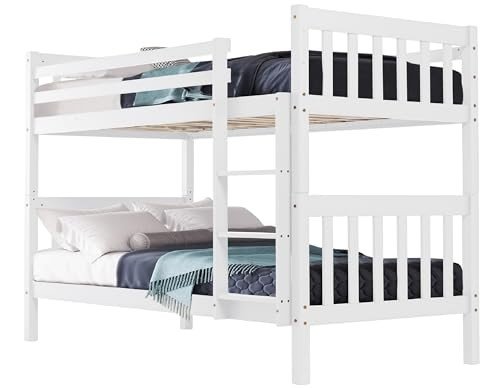The Next Big Thing In The Kids Bunk Bed Industry
The Ultimate Guide to Kids Bunk Beds: Maximizing Space and Fun
With the increase of vertical living and smaller sized spaces, the popularity of bunk beds has soared among families. Bunk beds not just use a useful sleeping option, specifically in shared rooms, but they likewise bring an aspect of fun into a kid's life. This thorough guide looks into the features, benefits, and considerations of kids' bunk beds, making it much easier for parents to choose the right bed for their children.
Features of Kids Bunk Beds
Bunk beds are versatile furniture pieces that serve more than a single function. Here are some essential functions to think about:
Feature
Description
Material
Bunk beds can be built from wood, metal, or a mix of both, using differing levels of sturdiness and style choices.
Security Features
The majority of bunk beds come geared up with guardrails, safe ladders, and capped assistances for security, particularly crucial for young kids.
Design Variety
Choices range from timeless designs to modern styles, making sure a match for any room decoration.
Space-Efficiency
Bunk beds make use of vertical space, making them ideal for smaller spaces.
Convertible Options
Some models can be transformed into two separate beds, providing versatility as children grow.
Storage Solutions
Some bunk beds come with integrated storage drawers or racks, helping to keep the room arranged.
Advantages of Kids Bunk Beds
Purchasing a bunk bed comes with several advantages:
- Space Saving: Bunk beds optimize floor space, enabling for more backyard or storage services.
- Fun Factor: With a bunk bed, kids belong that fosters imagination and companionship during pajama parties or playdates.
- Affordable: Instead of purchasing two different beds, a bunk bed can accommodate two kids simultaneously, saving money in the long run.
- Adaptability: Many bunk beds can be taken apart or transformed into twin beds, making them a long-term investment as kids's requirements change.
- Social Interaction: Bunk beds encourage household bonding and relationships, supplying a welcoming space for children to share stories and laughter.
Considerations When Choosing a Kids Bunk Bed
When selecting the perfect bunk bed for a child, moms and dads should consider different factors:
- Safety Standards: Ensure that the bunk bed adhere to security regulations and includes essential safety functions.
- Age Appropriateness: Different designs cater to different age groups. For example, standard bunk beds may not be ideal for more youthful children.
- Room Dimensions: Measure the bed room to ensure the bunk bed fits properly, permitting for space to move around easily.
- Weight Capacity: Consider the weight load of each bed and guarantee it accommodates the child's weight conveniently.
- Style Preferences: Letting kids take part in the choice process can help them feel more ecstatic about their brand-new bed.
Types of Kids Bunk Beds
Bunk beds come in different designs and configurations to suit numerous needs:
Type
Description
Standard Bunk Bed
A timeless style with one bed stacked on top of another, usually using a ladder to access the top bunk.
L-Shaped Bunk Bed
Features 2 bunk beds linked in an L-shape, often more roomy and suitable for kids sharing a space but needing a bit more space.
Triple Bunk Bed
Consists of three stacked beds, perfect for optimizing sleeping plans in extremely restricted areas.
Loft Bed
A raised bed with space beneath that can work as a backyard, research study corner, or additional storage.
Futon Bunk Bed
Combines a bunk bed on top with a futon or sofa beneath, making it great for pajama parties and taking full advantage of space usage.
Convertible Bunk Bed
Can be separated into 2 specific beds, providing flexibility as children's needs change.
Caring for Kids Bunk Beds
Preserving bunk beds is important for ensuring longevity and safety. Here are some simple care practices:
- Regular Inspections: Check the bed routinely for loose screws and tightened bolts to make sure stability.
- Cleanliness: Keep bedding tidy and fresh, turning bed mattress for even wear.
- Guardrails: Ensure guardrails are safe and secure and in location, particularly if kids tend to move a lot in their sleep.
- Air Circulation: Ensure the bed has enough airflow, preventing wetness buildup that can lead to mold or mildew.
Frequently Asked Questions About Kids Bunk Beds
Q1: At what age can a kid securely utilize a bunk bed?
A1: Generally, kids aged 6 and older are considered safe to use the upper bunk due to the height and stability elements included.
Q2: Can I put a bunk bed near a window?
A2: It is a good idea to prevent putting a bunk bed near windows to lower the risk of falling or injuries.
Q3: Are bunk beds safe for more youthful children?
A3: While some contemporary bunk beds come with security functions accommodating more youthful kids, it is normally suggested to wait till they are older, normally over six years.
Q4: What is the normal weight limitation for leading bunks?
A4: Weight limits differ by design however usually vary from 150 to 250 pounds. Constantly describe the manufacturer's requirements.
Q5: How often should I check the bunk bed's safety features?
A5: It is a good idea to perform a safety check every couple of months or whenever you notice any signs of wear.
Kids' bunk beds serve as a strategic solution for households seeking to take full advantage of space while offering a fun and appealing sleeping environment for their children. With a range of alternatives offered— from standard styles to loft beds— parents have the freedom to choose something that meets their household's particular needs. By thinking about extra resources as safety, room suitability, and their children's preferences, moms and dads can make an informed option, guaranteeing that each child is delighted about bedtime while benefiting from an efficient room.
